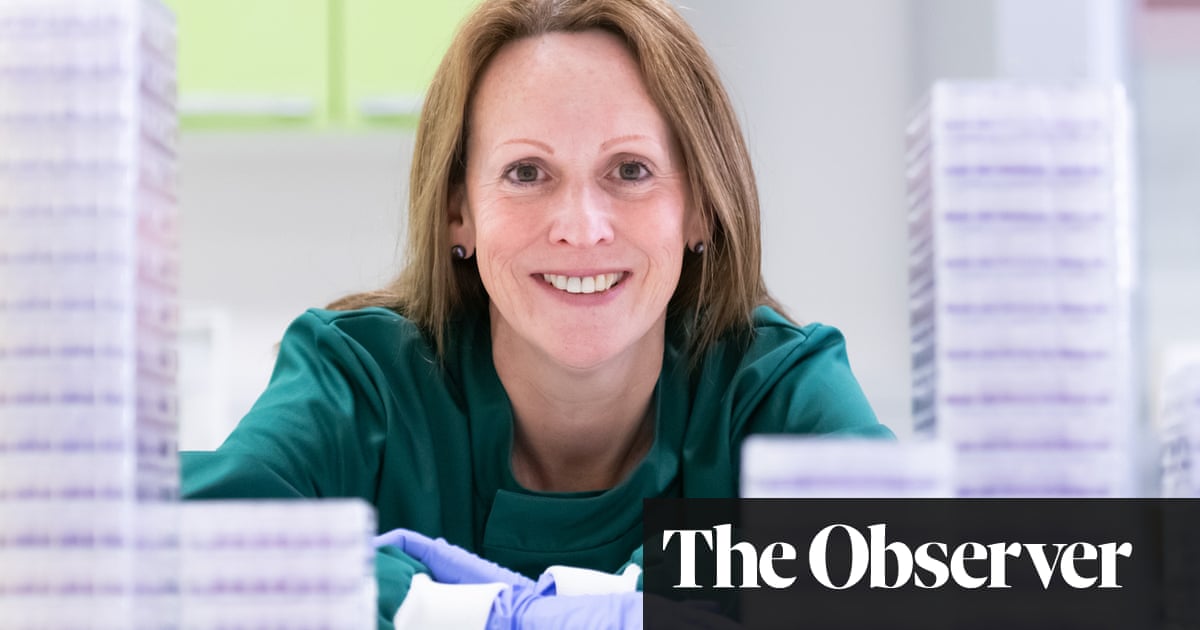Wendy Barclay is a leading British virologist and head of the department of infectious disease and the Action Medical Research chair in virology at Imperial College London. An expert on the pathogenesis and transmissibility of influenza viruses, she served on the Scientific Advisory Group for Emergencies (Sage) and the New and Emerging Respiratory Virus Threats Advisory Group (Nervtag) during the Covid-19 pandemic, providing advice on the risks posed by the coronavirus and appropriate medical countermeasures.
What prompted you to study virology?
After I graduated from Cambridge with a degree in natural sciences I thought I might get a job with a pharmaceutical company. Then I saw that the Common Cold Unit in Salisbury was looking for a PhD to work on rhinoviruses, the viruses that cause the common cold. I hadn’t studied viruses before, but that same year – 1988 – the first crystal structure of a virus was published and it was a rhinovirus. The Common Cold Unit was a steep learning curve.
Have there been times when it’s been difficult to be a woman working in virology?
Yes. There’s a famous “silver teapot” story I tell about my time as a junior lecturer, where I was always being dragged on to interview panels as the token woman. On one occasion, the dean of chemistry turned to me and said: “I’ll take mine with milk and two sugars.” The other men in the room cringed with embarrassment and leapt forward to pour the tea before I could. I think it’s important for women working in science to have female role models. I’m a head of department at Imperial and I’m proud to say I’ve recruited several young female lecturers, who are all excellent. I firmly believe that’s because they can see that Imperial is a place where women can thrive and become leaders.
Tell us about your research into H5N1 bird flu. What is it about the virus that keeps scientists up at night?
Bird flu viruses are circulating all the time. The H5N1 subtype that is causing so much concern at the moment first infected humans in 1997, but although it caused severe disease it never took off as a pandemic. Afterwards, it retracted back into the wild bird population, but it never really went away: we saw widespread outbreaks in poultry, with some human cases, in the early 2000s. Then, in 2014, it reared its head again. The problem is these wild avian viruses are mixing up their genetics all the time. It’s like viral sex on steroids. At some point, they come up with a solution that improves their fitness and their ability to infect new hosts.
So, what’s going on now?
In 2020, a new H5N1 variant, known as clade 2.3.4.4b, emerged. Wild birds spread it across huge areas and it did what influenza always does in wild birds, it shuffled its genome around. Some strains have also infected a wide range of mammals, including cows. There it appears to be highly concentrated in the teats and mammary glands and when you plop another cow on to the same milking machine it transfers from one cow to the other. Influenza has not been reported before in cows and the virus is replicating so well in them that we suspected that between crossing from birds and becoming established in these herds, the virus must have undergone adaptive mutations.
I believe you have just circulated a new pre-print (draft research paper) describing some of these mutations.
Yes, I’ve been heading a consortium of UK-based influenza virologists researching how the virus is evolving. In a recent study, we identified two key mutations that have enabled the virus to replicate more efficiently inside the cells of infected cattle. The worrying thing is that the same mutations also enable the virus to replicate better in pig and human cells, meaning it has moved one step closer to being adapted for humans. We also found that the clade 2.3.4.4b viruses have picked up a different neuraminidase gene (the N in H5N1) than the older viruses of the early 2000s. The new N helps the virus cut through human mucus more efficiently and target cells in our nose and throat more readily. This is yet one more block that the clade 2.3.4.4b viruses have overcome to becoming human adapted.
So how concerned should we be?
Whenever bird flu gets into any mammals it undergoes mutations that can bring it a little closer to being the sort of virus that can spread between humans. To date, we’ve seen 66 confirmed and eight probable human cases of the clade 2.3.4.4b H5N1 virus in the US. Two of these, one in British Columbia, the other in Louisiana, caused severe illnesses. Earlier this month, the patient from Louisiana died.
Does this mean we should expect a pandemic of H5N1 imminently?
Not necessarily. The virus is able to replicate inside human cells but has not acquired the set of mutations in the HA gene (the H in H5N1) required to transmit between people through the air. From laboratory studies of influenza we know that, to transmit, the virus must switch to use a human receptor, but receptor switching is not enough on its own to support airborne transmission. You need a second change that makes the H more stable in harsh environments like the droplets we breathe out from our respiratory tract. We haven’t seen any evidence of that yet, either in people, cows or any animals in the wild.
How prepared are we for a bird flu pandemic? And what if the next pandemic was sparked by a “Disease X”, a pathogen unknown to science?
The good news is that the World Health Organization has been keeping pace with the evolution of the bird flu virus and we have vaccine seed strains that could be used to make lots of vaccine in the event of an outbreak. We also have tried and tested licensed antiviral drugs, like Tamiflu and Relenza. And thanks to mRNA vaccine technology, pharmaceutical companies are also in a much better position to make vaccines against a new virus, including a new flu strain or another novel coronavirus.
If there was a bird flu pandemic and we had to resort to lockdowns again, do you think people would be as compliant as before?
No, I think they would struggle. If there’s a two- to three-day turnaround to get a diagnosis and people are having to miss work when they need to earn money, it’s understandably a very difficult decision. But one of the great things we learned during Covid is that people are capable of using home diagnostic kits – swabbing their nose and throat to test for infection. Maybe I have an optimistic view of humanity but my vision is for a test in everyone’s bathroom cabinet. Then, when you hear that a new virus is spreading, you can make a socially responsible decision to test and whether to go out or not.
Article by:Source: Mark Honigsbaum











